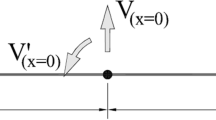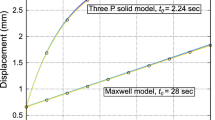Abstract
Most existing formulations for structural elements such as beams, plates and shells do not allow for the use of general nonlinear constitutive models in a straightforward manner. Furthermore, such structural element models, due to the nature of the generalized coordinates used, do not capture some Poisson modes such as the ones that couple the deformation of the cross section of the structural element and stretch and bending. In this paper, beam models that employ general nonlinear constitutive equations are presented using finite elements based on the nonlinear absolute nodal coordinate formulation. This formulation relaxes the assumptions of the Euler–Bernoulli and Timoshenko beam theories, and allows for the use of general nonlinear constitutive models. The finite elements based on the absolute nodal coordinate formulation also allow for the rotation as well as the deformation of the cross section, thereby capturing Poisson modes which can not be captured using other beam models. In this investigation, three different nonlinear constitutive models based on the hyper-elasticity theory are considered. These three models are based on the Neo–Hookean constitutive law for compressible materials, the Neo–Hookean constitutive law for incompressible materials, and the Mooney–Rivlin constitutive law in which the material is assumed to be incompressible. These models, which allow capturing Poisson modes, are suitable for many materials and applications, including rubber-like materials and biological tissues which are governed by nonlinear elastic behavior. Numerical examples that demonstrate the implementation of these nonlinear constitutive models in the absolute nodal coordinate formulation are presented. The results obtained using the nonlinear and linear constitutive models are compared in this study. These results show that the use of nonlinear constitutive models can significantly enhance the performance and improve the computational efficiency of the finite element models based on the absolute nodal coordinate formulation. The results also show that when linear constitutive models are used in the large deformation analysis, singular configurations are encountered and basic formulas such as Nanson’s formula are no longer valid. These singular deformation configurations are not encountered when the nonlinear constitutive models are used.
Similar content being viewed by others
References
Bonet, J., Wood, R.D.: Nonlinear Continuum Mechanics for Finite Element Analysis, Cambridge University Press, Cambridge (1997)
Dufva, K., Kerkkänen, K., Maqueda, L.G., Shabana, A.A.: Nonlinear dynamics of three-dimensional belt drives using the finite-element method. Nonlinear Dyn. 48, 449–466 (2007)
Gerstmayr, J., Shabana, A.A.: Analysis of thin beams and cables using the absolute nodal coordinate formulation. Technical Report MBS05-3-UIC (2005)
Hjelmstad, K.D.: Fundamentals of Structural Mechanics. 2nd edn. Springer, Berlin (2005)
Hussein, B.A., Sugiyama, H., Shabana, A.A.: Absolute nodal coordinate formulation coupled deformation modes: problem definition. Technical Report MBS06-1-UIC, Department of Mechanical Engineering, University of Illinois at Chicago (2006)
Kerkkanen, K.S., Garcia-Vallejo, D., Mikkola, A.M.: Modeling of belt-drives using a large deformation finite element formulation. Nonlinear Dyn. 43, 239–256 (2006)
Maqueda, L.G., Bauchau, O.A., Shabana, A.A.: Effect of the centrifugal forces on the finite element eigenvalue solution. Technical Report # MBS06-4-UIC, Department of Mechanical Engineering, The University of Illinois at Chicago, November 2006
Mikkola, A.M., Matikainen, M.K.: Development of elastic forces for the large deformation plate element based on the absolute nodal coordinate formulation. ASME J. Comput. Nonlinear Dyn. 1, 103–108 (2006)
Ogden, R.W.: Large deformation isotropic elasticity: on the correlation of theory and experiment for compressible rubber-like solids. Proc. Roy. Soc. Lond. Ser. A: Math. Phys. Sci. 328, 567–583 (1972)
Ogden, R.W.: Non-Linear Elastic Deformations. Horwood, Chichester (1984)
Omar, M.A., Shabana, A.A.: A two-dimensional shear deformable beam for large rotation and deformation problems. J. Sound Vib. 243, 565–576 (2001)
Reissner, E.: On a variational theorem for finite elastic deformation. J. Math. Phys. 32, 129–135 (1953)
Schwab, A.L., Meijaard, J.P.: Comparison of three-dimensional flexible beam elements for dynamic analysis: finite element method and absolute nodal coordinate formulation. In: Proceedings of ASME International Design Engineering Technical Conferences and Computer Information in Engineering Conference (DETC2005/ MSNDC-85104), Long Beach, CA, USA (2005)
Shabana, A.A.: Resonance conditions and deformable body co-ordinate systems. J. Sound Vib. 192, 389–398 (1996)
Shabana, A.A., Yakoub, R.Y.: Three-dimensional absolute nodal coordinate formulation for beam elements: theory. ASME J. Mech. Des. 123, 606–613 (2001)
Simo, J.C., Taylor, R.L.: Penalty function formulations for incompressible nonlinear elastostatic. Comput. Methods Appl. Mech. Eng. 35, 107–118 (1982)
Simo, J.C., Taylor, R.L., Pister, K.S.: Variational and projection methods for the volume constraint in finite deformation elastoplasticity. Comput. Methods Appl. Mech. Eng. 51, 177–208 (1985)
Simo, J.C., Taylor, R.L.: Quasi-incompressible finite elasticity in principle stretches. Continuum basis and numerical algorithms. Comput. Methods Appl. Mech. Eng. 85, 273–310 (1991)
Sopanen, J.T., Mikkola, A.K.: Description of elastic forces in absolute nodal coordinate formulation. Nonlinear Dyn. 34, 53–74 (2003)
Spencer, A.J.M.: Continuum Mechanics. Longman, Harlow (1980)
Treloar, L.R.G.: Physics of Rubber Elasticity. Oxford University Press, Oxford (1958)
Yakoub, R.Y., Shabana, A.A.: Three-dimensional absolute nodal coordinate formulation for beam elements: implementation and applications. ASME J. Mech. Des. 123, 614–621 (2001)
Yoo, W.S., Lee, J.H., Park, S.J., Sohn, J.H., Pogorelov, D., Dimitrochenko, O.: Large deflection analysis of a thin plate: computer simulation and experiment. Multibody Syst. Dyn. 11(2), 185–208 (2004)
Author information
Authors and Affiliations
Corresponding author
Rights and permissions
About this article
Cite this article
Maqueda, L.G., Shabana, A.A. Poisson modes and general nonlinear constitutive models in the large displacement analysis of beams. Multibody Syst Dyn 18, 375–396 (2007). https://doi.org/10.1007/s11044-007-9077-z
Received:
Accepted:
Published:
Issue Date:
DOI: https://doi.org/10.1007/s11044-007-9077-z




